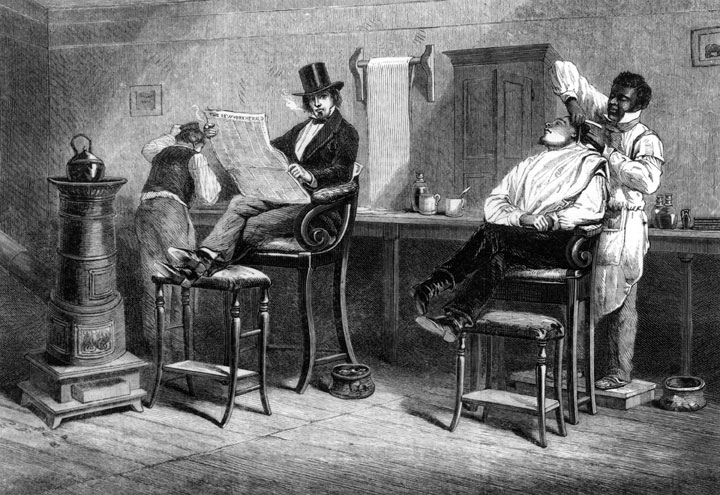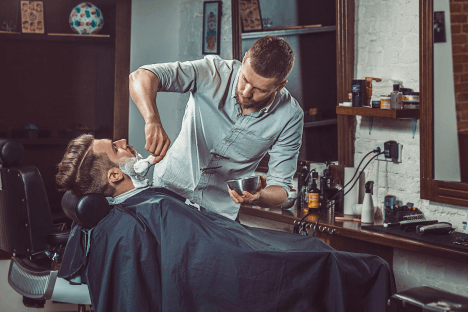April 23, 2018
The History of Barbering. A Short Journey.
“Shave and a haircut, 2 bits!” – This phrase used to be the calling card of barbers everywhere, but it’s one you’re not likely to hear nowadays–after all, 2 bits is only roughly about 25 cents! Still, if you’re considering a career in barbering, it’s worth exploring some of the history behind this craft before you attend a Nebraska cosmetology school to gain the skills you need for this exciting career.
The history of barbering is an interesting one, and you may be surprised at some of the highlights of the backstory of this profession. Join us for a brief walk through history, see where barbering began, and how it became one of the pioneer programs at Xenon Academy.
Roots in the Bronze Age
Among many surprising discoveries in the ruins of Egyptian civilization, historians uncovered a straight razor (or an object that heavily resembled one) dating back to nearly 3500 BC. Back then, the idea of a barber wasn’t anything close to what it is in the modern era. However, this discovery showed that the idea of grooming and health had always been part of the culture. Men of this era favored thick beards and long hair, as these were traits associated with manliness in depictions of gods and kings.
Flash forward a few centuries, and the barbering profession was solidified in high society. Derived from the Latin word for beard, barbers were a staple of the wealthy aristocrats in both ancient Greek and Roman societies. At this time, much of their focus was on the “beautification” of the male body with cleansers and other pampering techniques, not so much on hair care.
By the 1700s, much of a barber’s job involved shaving and perfuming men’s faces, as well as styling and arranging women’s hair along with the wigs worn by both men and women.

Barbers As the First Physicians
Barbering may seem pretty straightforward. A shave, a haircut, some styling products, and you’re out the door. But starting in the late 1700s to early 1800s barbers began to take on other responsibilities–including those of the community doctor.
With the field of medicine still in its infancy, many barbers began offering services such as bloodletting, cupping, and even amputations and teeth extraction. Known as “barber-surgeons” these skilled men are actually where the iconic striped barber pole comes from.
The red, white, and blue stripes represent the white bandages, blue veins, and red blood that would be used by barber-surgeons through the Civil War when things in the world of barbering began to change.
Defining a Well-Groomed Man
In the mid-1800s, the beard began to come back in style, but while the barbers of today may specialize in perfectly trimming a beard, it wasn’t a skill that was common in those times. As barbers began to conform to the new style trends, the field of medicine expanded, and “barber-surgeons” were replaced by physicians with training and pedigrees.
As the Civil War ended and an influx of immigrants began to enter the U.S., barbers were suddenly more sought after, turning this once unregulated area into an in-demand field with a demand for skilled training. In 1893, the first barber school was opened in Chicago by A.B. Moler, complete with textbooks and a full curriculum. It was perfect timing, as around that time states began passing laws requiring barbers to gain licenses and pass exams to ensure health and quality standards were met. Soon, barber and beauty schools began popping up all over the country.
Growing a New Profession with Modern Styles
Commonly known as a “Dapper”, well-groomed men of the early 1900s were known for crisp cuts, pomade, and perfectly groomed mustaches. As the world broke into war, however, the well-groomed man was moved to the front lines, and many of the barbers went alongside. This shift made room for the first cosmetologists of the day, with women’s hairstyling becoming an important part of American culture.
By the 1950s, barbering came back into full swing, as men were returning home and seeking professional looks to bring them back into the workforce. Today cosmetology and barbering go hand in hand, but in the mid-20th century, the two were distinct professions.
By the end of the 60s, men’s style was changing. Classic sporting cuts were falling out of style, and more intricate long hairstyles were all the rage–think mop tops, hippie-inspired flowing locks, and pompadours. As a result, barbers became more specialized offering unique styles and client experiences catering to a more diverse clientele and evolving fashion trends. However, some barbers refused to adapt to the demand for longer hairstyles popularized by musicians of the era–such as the Beatles and their famous bowl cuts–and they soon found themselves out of business. There was also a rise in family hair salons offering services to a broad range of clients, making dedicated barbershops a less common fixture across the U.S.
The Modern Barber
Barbering has changed over the centuries, but it has always been a specialized profession aimed at helping people look their best. Modern barbers cater to men and women, specializing in short hairstyles, beard trimming, and facial grooming. Attending barber college today, you can expect to learn skills including scalp care, hair design, anatomy and physiology, chemical treatments, facial massage, beard trimming, and the salon business knowledge you need to build a career with these skills.

At Xenon Academy we are proud to have been at the forefront of the return of barbering in our generation. We were among the pioneering schools to work with American Crew as they created a barbering education program in the early 2000s. We have continued this tradition as we move into a relationship with Pivot Point, which will help us build the next generation of barbering professionals. Our barbering students put their education to work during their training by providing services to real clients in our student salon using Redken Brews and Reuzel products.*
Are you interested in attending barber school in Nebraska?
Here at Xenon Academy, we are a licensed barber school. Contact us today to see how we can help you grow the skills you need to build a new future and carry the banner of barbering on to a new generation.
*All services performed by students under the supervision of licensed instructors.
Leave a Reply